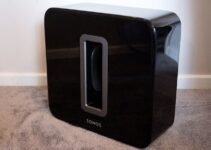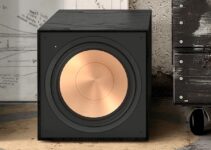If you’re experiencing issues with your Logitech subwoofer not working, don’t worry, you’re not alone. There are several reasons for this that come with easy fixes. However, you could also be dealing with a complex issue that requires a professional touch.
In this guide, we’ll walk you through some troubleshooting steps to help you get your subwoofer back up and running.

Logitech Subwoofer Not Working: How to Troubleshoot
These troubleshooting steps should help you to identify the problem and get it fixed.
Fix 1: Check the Power
The first thing to check is definitely the easiest. Though it is also pretty obvious and something you’ve checked already. You need to confirm that your subwoofer is receiving power. Check if the power cable is correctly plugged into an outlet and the back of the subwoofer. Make sure that the outlet is working by plugging in a different device or appliance.
Fix 2: Check the Connection
The next step is to check the connection between your subwoofer and your audio source. Connection issues are quite common, so you need to confirm that the cable is firmly connected to the subwoofer and the audio source, whether it’s a computer, TV, or a sound system.
If your subwoofer is connected wirelessly, check if the wireless connection is established. To avoid interference, make sure that the subwoofer is within the range of the audio source, and that there are no obstacles interfering with the signal.
Fix 3: Check the Volume Levels
Sometimes, the issue might not be with the subwoofer itself, but rather the volume levels. Check if the volume levels on the audio source and the subwoofer are turned up. You can also check if the subwoofer’s gain knob is turned up, which controls the volume level of the subwoofer.
Fix 4: Check the Audio Settings
If the above steps didn’t solve the issue, it’s time to check the audio settings on your audio source. Check the audio output to see if it is set to the correct device, and the audio is set to stereo or 2.1 channels.
If you’re connected via a computer, you can check the audio settings in the sound control panel. Ensure that the subwoofer is selected as the default device and that the audio is set to stereo or 2.1 channels.
Fix 5: Update the Drivers
If you’re still having trouble, then you would have to check the drivers. Check if the drivers for your audio device and subwoofer are up to date.
On a Windows computer, go to the Device Manager, locate the audio device, right-click it, and select “Update Driver Software.” If you’re using a Mac, go to the App Store and check if there are any available updates for your audio device.
Fix 6: Check the Fuse
If your subwoofer is still not receiving power, then you might have to conclude that the fuse has blown. The fuse prevents electrical surges from damaging the subwoofer.
You can check the fuse on the back of the subwoofer, and if it’s blown, replace it with a new one of the same rating.
To replace the fuse, unplug the subwoofer from the power source, remove the fuse cover, and carefully remove the old fuse. Insert the new fuse and replace the cover.
Fix 7: Check the Subwoofer’s Speaker
If you’re still experiencing power issues with your subwoofer, you might want to check the subwoofer’s speaker. Check if the speaker is damaged or blown by inspecting it visually or by listening to it.
If you notice any damage or the speaker is blown, you will need to replace it. You can purchase replacement speakers online or from an electronics store.
Replacing the speaker can be tough to handle, especially if you’re not tech-savvy. It might be best to seek professional assistance. If you prefer to do it yourself, follow the instructions in the subwoofer’s manual.
Fix 8: Reset the Subwoofer
Sometimes, resetting the subwoofer can help fix any software or firmware issues. To reset the subwoofer, unplug it from the power source, wait for a few minutes, and plug it back in.
Once the subwoofer is powered on, check if the issue has been fixed. If not, try resetting the subwoofer again, but this time, hold down the reset button for a few seconds before releasing it.
Fix 9: Check the Audio Source
The next place to check is the audio source. Try playing audio from a different source, such as a different computer, phone, or tablet.
If the subwoofer works with the new source, then the issue is with the previous audio source. You can try updating the drivers or checking the audio settings on the previous source.
Fix 10: Use an Audio Converter
If you’re using an older audio source, it’s possible that it doesn’t support the subwoofer. In this case, you can use an audio converter to connect the subwoofer to the audio source.
An audio converter is a device that converts the audio signal from one type of connector to another.
Connect the audio converter to the audio source and the subwoofer, and check if the issue is resolved.
Fix 11: Contact Support
If none of the above steps helped, you’ve done your best and it’s time to contact support. Logitech has an excellent support team that can help you troubleshoot your subwoofer issue. You can contact them through their website or by phone.
Final Thoughts
The subwoofer in your speaker system is designed to produce low-frequency sounds and adding depth to your audio. If it fails to operate correctly, you will notice a drop in the quality of your music or movie experience.
Using these fixes, you should be able to troubleshoot your Logitech subwoofer and get it back up and running. If you’re still not able to get it fixed after following the steps above, you can always reach out to Logitech support for additional help. You might also want to consider your warranty as this could help you get the issue fixed for free.





![Samsung Subwoofer Won’t Connect to Soundbar [FIXED] Samsung Subwoofer Won’t Connect to Soundbar [FIXED]](https://audiojust.com/wp-content/uploads/2023/05/samsung-subwoofer-wont-connect-to-soundbar-211x150.jpg)
![LG Subwoofer Not Connecting to Soundbar [Solved] LG Subwoofer Not Connecting to Soundbar [Solved]](https://audiojust.com/wp-content/uploads/2022/12/lg-subwoofer-not-connecting-to-soundbar-211x150.jpg)

![Samsung Subwoofer’s Blue Light On But No Sound [FIXED] Samsung Subwoofer’s Blue Light On But No Sound [FIXED]](https://audiojust.com/wp-content/uploads/2022/12/samsung-subwoofer-blue-light-on-but-no-sound-211x150.jpg)
